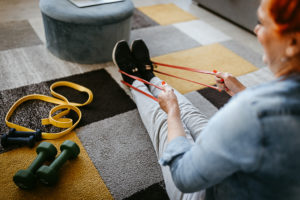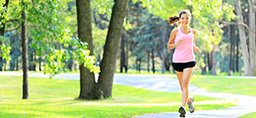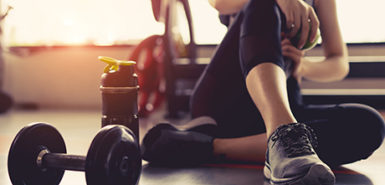
When it comes to fitness, it’s easy to spend big.
Annual gym memberships can cost hundreds of dollars—or sometimes thousands—each year.
Some people spend anywhere from $60 to $100 an hour on a personal trainer. Others invest thousands in stationary cycles, treadmills and connected fitness devices at home.
But fitness can be far more affordable—and low-budget workouts are just as effective, said Matt Axtman, DO, a sports medicine specialist at Corewell Health.
Start with the only two pieces of equipment that are non-negotiable: The right shoes.
“Whether you’re walking or running, it’s important to get shoes that fit your foot well,” Dr. Axtman said.
That means shopping at a shoe store with sales personnel who will observe customers and evaluate their gait and foot-strike tendencies.
“They can get you on a treadmill and make solid recommendations based on what they see,” he said.
And yes, they may try to steer you toward high-end shoes, which often cost upwards of $175.
“If you press them, they’ll be able to steer you toward more affordable options,” he said.
Dr. Axtman would know—he runs in a now-discontinued Adidas model that he buys in bulk online, at $40 a pair.
Many shoe stores often have generous return policies, and most shoes last between 300 to 500 miles, he said.
“And when it’s time to get a new pair, wean yourself, wearing the new shoes for a workout or two, then switching back to the old,” he said. “That way, you can get your feet used to the change.”
Once you’ve chosen the right shoes for walking or running, you should target cardio exercises.
Adults should aim for 150 minutes of brisk activity a week, broken up how you’d like—whether that’s 30-minute jogs, 10-minute walks or long weekend hikes.
Build strength for free
Guidelines also call for adults to get in two strength-training sessions each week. Some of the best strength training in the world is 100% free, using nothing but body weight, said Mychael King, a former Corewell Health fitness professional.
He recommends a simple routine of old-school moves, building on basics.
“Lunges help support your runs and walks and improve body mechanics,” he said. “They’re probably everybody’s least favorite, but the most beneficial.”
Squats come next. Modify them according to your age and activity level, but don’t skimp.
“They build bone density, increase flexibility and strengthen your core and glutes—all important to aging well and preventing injury,” he said.
Then bring on the pushups to work the arms and upper body. They can be modified to any fitness level.
Just starting? Perform pushups against the wall or countertop.
For core strength, use old-fashioned crunches and sit-ups, taking care not to yank on your neck. Planks also build core strength.
Once you’ve got a routine that includes those basics, increase the intensity.
“Burpees are a great way to increase heart rate,” he said. “So are inchworms.”
King is also a fan of incorporating non-equipment into workouts. “It’s fun to do pull-ups at local playgrounds or use a broomstick across the shoulders for rotating lunges,” he said. “Sometimes, I do squats while holding a case of water.”
Unsure about any of these moves? YouTube and other sites are full of free advice. The American Council on Exercise is a great source that offers instructions, videos and workouts for all fitness levels.
Affordable options
With minimal investment, you can crank up the challenge.
Fitness bands are the best bargain in all of strength training, King said. They offer as much challenge as a room full of weights—for less than $15. They take up little space, they’re easy to pack and they won’t tear up floors.
Best of all, they’re easy to use. Research online to find workout options, then experiment to find one at your level.
“These bands are amazing tools,” King said.
Consider adding a balance trainer, such as a Bosu ball. Some cost as much as $150, but others are in the $60 range.
“They boost balance skills and offer a good core workout, and also target the gluteal muscles, which are easy to neglect,” Dr. Axtman said.
Got a bike? King suggests buying a stand to turn it into a stationary bike during cold-weather months for affordable indoor cardio.
Up your game
Once you’ve established a routine and know you’re disciplined enough to benefit from home workouts, it may be time to spend a little more. Focus on what you enjoy the most.
Weights are expensive, with new dumbbells costing up to $4 a pound. So are kettlebells, which are beloved for a reason—they offer a great workout.
Before buying anything new, they recommend looking on secondhand sites such as Craigslist and Facebook Marketplace, or at yard sales and secondhand sports stores.
King has had some fantastic luck at auctions.
“It’s tough to run a successful gym,” he said. “And when they go out of business, you can get deals.”
He once scored a higher-end Schwinn bike for just $50.
Think hard before investing
As your fitness commitment grows, it may be time to consider a high-end investment. A runner determined to train for a marathon, for instance, would benefit from a treadmill, especially given the nature of Michigan winters.
But give it careful consideration, especially since retailers often tempt consumers with buy now, pay later financing.
“Before going into debt for a big fitness purchase, ask yourself what your motivation is,” Dr. Axtman said. “The question is, ‘Am I determined to use this equipment?'”
Someone who is committed may indeed consider their health and fitness well worth the expense.
Others might just wind up adding financial stress to the guilt that comes from buying equipment that turns into a dust collector.
No matter how you decide to equip your home gym, give it star billing in your house.
“The most important thing you can do is create an environment at home that’s conducive to working out,” King said. “Put it in the middle of your living room to motivate you, not off to one side where you can forget about it.
“It’s all about the power of your choices.”
 /a>
/a>
 /a>
/a>
 /a>
/a>
Awesome article and the information shared by the author is really helpful for everyone. Please keep sharing.